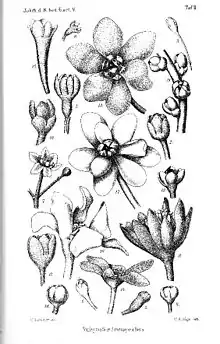| Dicypellium | |
|---|---|
 | |
| Illustration 17: Dicypellium caryophyllatum | |
| Scientific classification | |
| Kingdom: | Plantae |
| Clade: | Tracheophytes |
| Clade: | Angiosperms |
| Clade: | Magnoliids |
| Order: | Laurales |
| Family: | Lauraceae |
| Genus: | Dicypellium Nees & Mart. |
| Species | |
| |
Dicypellium is a genus of two species of flowering plants in the family Lauraceae, native to tropical South America, in Amazon Basin.
Diagnostic characters: they are trees, with the flowers not involucrated, ovary superior, nine or fewer fertile stamens, anthers four-locular and nine tepals, and the fruit with cupules (see illustration).
Dicypellium caryophyllatum, known as "pau-cravo" in Brazil, has bark that smells like cloves.
References
- Rohwer, J. G.: The Genera Dicypellium, Phyllostemonodaphne, Systemonodaphne and Urbanodendron (Lauraceae). Botanische Jahrbücher für Systematik 110(2): 157–171, 1988.
This article is issued from Wikipedia. The text is licensed under Creative Commons - Attribution - Sharealike. Additional terms may apply for the media files.